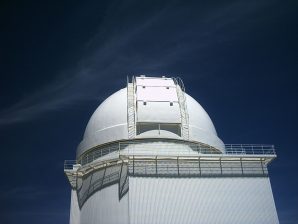Previous studies on the formation and evolution of spiral galaxies might have been based on a wrong assumption, suggests a team of researchers of Instituto de Astrofísica e Ciências do Espaço (IA).
Most spiral galaxies are characterized by a disk, where stars, gas and dust spread out in a characteristic pattern of twisted spiral arms, and a bright central area, named the bulge. When studying how galaxies form and evolve, it is crucial to differentiate between these two components. This represents a scientific challenge and previous studies have traditionally assumed that the disk brightness increases exponentially all the way to the galactic centre.
This common assumption is challenged in a study1, published in Astronomy & Astrophysics and authored by Iris Breda, Polychronis Papaderos and Jean Michel Gomes, of Instituto de Astrofísica e Ciências do Espaço (IA2). Using a new technique to separate the bulge from the disk applied to 135 spiral galaxies from the CALIFA survey3, the researchers found a lesser contribution of stars from the disk to the overall brightness of the galaxy centre. According to the authors, this has wide implications for studies on galaxy formation and evolution.

“We developed a new spectrophotometric bulge-disk decomposition technique that for the first time combines advanced spectral synthesis and surface photometry tools, including two developed at IA, the FADO and iFIT tools,” says Iris Breda, of IA and Universidade do Porto (U.Porto). “We used them to determine the maximum contribution of the disk inside the radius of the bulge. This technique, that we applied to a representative sample of spiral galaxies, has revealed that, in approximately one third of them, the disk beneath the bulge does not preserve its exponential profile, but shows instead a central flattening or even a strong decrease.”
If confirmed, this discovery implies that the relative amount contributed from disk and bulge stars to the galaxy centre is different than previously presented in a substantial number of studies that assumed an exponential increase up to the centre of the disk.
“This may, therefore, have far-reaching implications for our understanding of the structural and dynamical evolution of spiral galaxies,” Iris Breda.
Previous studies on spiral galaxy evolution may be flawed by assuming that the brightness contribution from stars intrinsic to the bulge is less significant than it actually is. For instance, in spiral galaxies in which the disk represents 80 percent of the luminosity in the central area, its overestimation may lead to an erroneous classification of the type of bulge.
This has even further implications when dealing with galaxies with intense activity in their cores associated with the presence of a supermassive black hole, the so-called Active Galactic Nucleus (AGN4). Polychronis Papaderos, from Faculdade de Ciências da Universidade de Lisboa (Ciências ULisboa) and leader of IA’s thematic line ‘The assembly history of galaxies resolved in space and time’ says: “The confirmation of a flattening or even down-bending of the density of the stellar population of the disk within the radius of the galactic bulge would imply an upward revision of mass determinations for galactic bulges. This, in turn, will presumably lead to a change in the mass correlation between bulge and supermassive black hole, and place important new constraints on galaxy formation models.”
NOTES:
- The article “Indications of the invalidity of the exponentiality of the disk within bulges of spiral galaxies”, by Iris Breda, Polychronis Papaderos and Jean-Michel Gomes was published online on the 3rd of August in the journal Astronomy & Astrophysics, Vol. 640 (DOI: 1051/0004-6361/202037889).
- The Instituto de Astrofísica e Ciências do Espaço (Institute of Astrophysics and Space Sciences – IA) is the reference Portuguese research unit in this field, integrating researchers from the University of Lisbon and the University of Porto, and encompasses most of the field’s national scientific output. It was evaluated as Excellent in the last evaluation of research and development units undertaken by Fundação para a Ciência e Tecnologia (FCT). IA’s activity is funded by national and international funds, including FCT/MCES (UIDB/04434/2020 e UIDP/04434/2020).
- The Calar Alto Legacy Integral Field spectroscopy Area survey (CALIFA) is an astronomical project with the goal of mapping approximately 600 galaxies in the local Universe using integral field spectroscopy (IFS), to allow detailed studies addressing fundamental issues in galaxy evolution. The data are collected by the 3.5 m telescope at the Calar Alto Observatory in Spain.
- An Active Galactic Nucleus (AGN) is a small region at the centre of a galaxy that emits an enormous amount of energy in the form of electromagnetic radiation. This radiation is thought to result from the accretion of matter by a supermassive black hole at the centre of the galaxy. AGN are the most luminous persistent sources of electromagnetic radiation known in the Universe.


